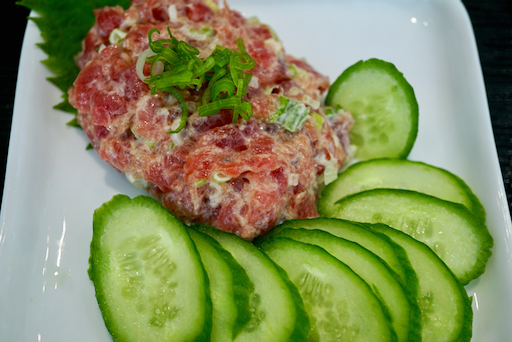Tuesday, September 27, 2016
Succotash soup with chicken salad サカタッシュ コーンスープ
Thursday, August 20, 2015
Bulgur wheat salad バルガーウィートのサラダ
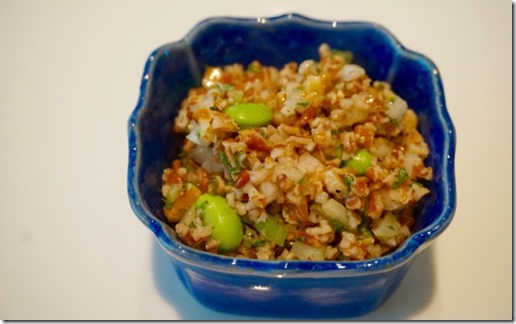
One of her secrets is to roast the bulgur wheat in the toaster oven. It adds a nice roasted flavor.
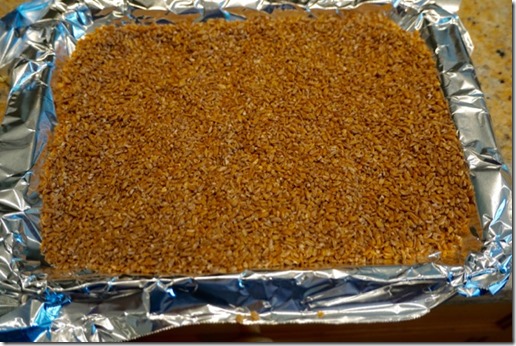
The dressing is simple. Finely chopped fresh mint really adds a fresh taste.
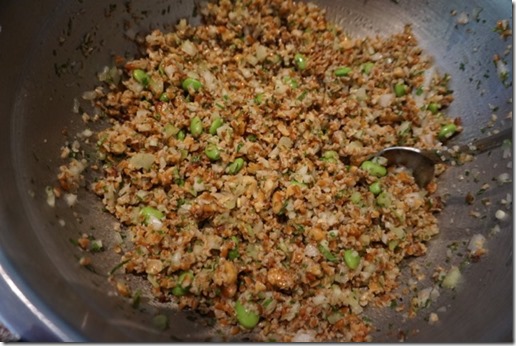
Ingredients:
1 cup Bulgur wheat
1/1/2 cup chicken broth
Celery
Walnuts (toasted with the brown skin rubbed off using a dish towel
Sweet onion (red or Vidalia)
edamame
Fresh mint
Dressing:
Rice vinegar/lemon juice
Olive oil
Salt and pepper
Toast the bulgar wheat in the toaster oven until it turns dark brown and exudes to sweet almost honey like aroma. Remove from the toaster oven and rinse in cold water. (At this point the wheat may be smoking a bit and steam will rise as it is rinsed). Put the chicken broth into a pan and bring to a boil. Add the rinsed bulgar wheat, put on the lid and remove from heat . Let it sit for about 20 minutes. Use a fork to fluff up the grains. If there is some liquid left drain the wheat and let it cool down.
Once the wheat has cooled add the other ingredients basically to taste. For example, add as much mint as tastes good.
This is a very nutty flavorful salad. The toasting adds a bit of sweetness.
Thursday, July 6, 2023
Sous Vide Chicken Breast with Red Pepper Sauce 低温調理鶏胸肉のロースト赤パプリカソース添え

Ingredients:
Two roasted red peppers, stem end and skin removed, seeds and ribs removed, cut into small size (for pureeing)
1/2 sweet (Vidalia) onion, finely chopped
1 tbs caper
1 tbs lemon juice
3-4 tbs olive oil
Salt and pepper to taste
Directions:
Add all the ingredients except the salt and pepper in a cylindrical container for an emersion blender.
Puree on high-speed until smooth. Taste and add salt and pepper
This sauce went very well with the sous vide chicken breast. The chicken cooked this way is very moist and tender but can taste a bit bland. The sauce really added a nice slightly tangy flavor. We still have a lot of sauce left so there will be more to come.
Monday, August 9, 2021
Tako Grill Take-out タコグリルからテイクアウト
Although someday, we may be able to dine-in again, we are quite happy with this arrangement. We also get some Japanese groceries which is definitively a big plus. We are regularly getting frozen edamame (they have the best quality edamame), Japanese crackers (especially my wife likes them), Tonkotsu ramen, and green tea ice cream daifuku among others. We hope this new format will work for Tako Grill as a business. We are certainly very happy with this format.
Saturday, September 7, 2013
Japanese-style succotash 枝豆ととうもろこしのバター醤油ソテー
This was second dish I made from the leftover soy beans or edamame (hulled and frozen in a microwavable pouch). I saw the original recipe on line but this is very similar to the American summer favorite succotash except for the use of soy bean instead of Lima beans and soy sauce for seasoning. The combination of butter and soy sauce is almost fail-safe and add the flavor of sweet corn, it is extremely good.

Corn: I got four ears of fresh corn. As per my wife's method, after removing the husks and silk, I placed them on a plate covered loosely with paper towels and microwaved them for 4 minutes, turned them over and microwaved for additional 2 minutes. (Of course you could boil the corn or use frozen.) My wife removed the kernels of the cooked corns for me.
Edamame: I used frozen, hulled soy beans in a microwavable pouch but fresh or frozen soy beans in pods can be also used (even better, I am sure) after cooking and removing the soy beans from the pods. The amount is arbitrary but I could have used more for the amount of corn I had.
I can think of adding other items such as finely diced tomatoes, shallot, Jalapeño pepper, red pepper etc but I made this with just corn and soy beans. I just sautéed the soy bean and corn mixture in large frying pan with butter (1 tbs) until all the vegetables are coated and warm. I then added soy sauce from the edge of the pan (so that soy sauce will be heated up quickly and become fragrant before mixing into the vegetables.) I added soy sauce in several increments as I tasted.
As we were preparing this, both my wife and I were snacking on them and without further seasoning these were good. The corn was very sweet. The addition of butter and soy sauce made it even better. This could be a drinking snack or a side dish. I served this with corn-meal crusted chicken tender loins on the top (which I did not take pictures).
Saturday, May 22, 2010
Sushi Taro, Dupont Circle, Washington DC 寿司太郎
This time we started off with home-made umeshu 梅酒 aperitif with green plum simmered in syrup or "kanroni" 青梅の甘露煮, a very nice refreshing start, which was followed by their signature appetizer Gomadofu 胡麻豆腐 topped with Maine sea urchin, real wasabi (every time wasabi was served, our chef grated a wasabi daikon root with a traditional sharkskin grater--the difference between this wasabi and the usual fake one from the tube was remarkable). Since it was in season, the next was Junsai ジュンサイ in sweet vinegar and yuzu 柚子. Junsai was very fresh with thick gelatinous layers. It matched perfectly with gentle sweet vinegar sauce highlighted with a bright yuzu flavor. (Masa showed us the fresh yuzu they had just received--the very small green kind). We then moved to a simmered dish; Hiryouzu 飛龍頭 and shrimp shinjou 海老しんじょう in yuba 湯葉 sauce. This was a nice comforting dish and well-prepared, if not spectacular. Next came a huge and fresh Pacific oyster (cut into three pieces) from Washington State, Japanese call it Iwagaki oyster 岩牡蛎, on the half shell with a lemon wedge and okinawan salt. This was so good (you may have noticed we are partial to raw oysters). It went so well with the sake we were drinking; a nice fresh ocean taste and, without any special sauce or seasoning, it lingered pleasantly in the mouth for a while. Again seasonality is important here. "Ayu" 鮎 is in season. Japanese, especially Kyotoites, are very fond of this small fresh water river fish and we had this fish quite a few times in Kyoto. The Ayu which had been marinated very delicately in soy sauce and sake 祐庵地 was served butterflied and grilled 鮎の開き祐庵焼き. I like this rendition much better than the customary "shioyaki"塩焼き or salt grilled, which is usually served on a bed of salt and pine needles. Somewhere between these dishes, we had assorted "Hassun" appetizers 八寸 with 8 small tasty morsels; kinome-miso dengaku 木の芽味噌田楽, "aburana" with yuzu-miso アブラナの柚子味噌和え, lightly marinated firefly squid 蛍イカの沖漬け, "tamago-dofu" 卵豆腐, a small savory egg custard square with edamame paste, salt-cured shirako 白子 with vinegard daikon strips, garlic sprouts 芽ニンニク with miso-marinated Manila clams. All were fantastic. The only slight disappointment being the dengaku due to the quality of the tofu which could have been better. The salt cured "Shirako" or cod sperm sac (which does not sound appetizing) was delicate and tasty.
Thursday, September 10, 2015
Cornish Game hen tarragon flavor タラゴン風味コーニッシュゲームヘン
We made quite a few varieties of salads on the weekend and I served these salads (bulgur wheat edamame, wheat berry with olives, and potato salad). The Cornish game hen was seasoned with fresh French tarragon (from our herb garden). For greens I also served broccolini, which was blanched and then sautéed in butter.

One of the original aims of developing Cornish game hens was to create a bird that was the perfect size for one serving but I served a half a bird per person but even this was, of course, too much for us.

At least, portions of the skin were crispy and somehow it tasted better than its larger brethren. Even the thigh meat was like white meat but juicer.

Preparing Cornish game hen:
Thaw (if frozen) and wash thoroughly inside and out. Using kitchen shears, cut along both sides of the back bone and butter-fly the bird by flattening it on a cutting board pressing on the breast bone using your palm. Using a chef’s knife or any heavy knife, cut through the middle of the breasts (through the sternum or keel bone) to make two halves. Season it with pepper, salt and finely chopped french tarragon.
Cooking:
Preheat the oven to 400F
In a large sauté pan which can hold two halves snugly, I added a small amount of olive oil and placed the chicken halves with the skin side down on medium high heat (placing weight such as a cast iron skillet make skin brown better). I browned the skin 5-6 minutes. I turned the chicken halves over and poured dry sherry (1 tbs) into the pan and put the lid on to steam. After 1 minute (or less) when the liquid was all gone, I removed the lid and transferred the pan to the preheated oven. When the internal temperature (near the hip joint not touching the bone) reached 165F (about 15 to 20 minutes), I removed the pan from the oven. I let the meat rest for 5-10 minutes.
We like Cornish game hens. They don’t taste gamey in any way. The meat is similar to any other chicken but more succulent and flavorful. It went very well with grain salads.
Monday, March 26, 2012
Hanami is over; one more dish, Burdock salad 花見は終わりです。牛蒡のサラダ
Carrot: I sliced and julienned carrot similar to the way I prepared burdock (1 small).
First dressing: I cooked burdock and carrot in salted boiling water with a dash of rice vinegar for 3-4 minutes. I then drained and mixed in the first dressing while it was hot (to add "shita-aji" 下味 or base flavor) consisting of rice vinegar (1 tbs), olive oil (1.5 tbs) seasoned with salt and pepper. I let it cool in the dressing to room temperature.
Meanwhile I prepared the pork and cucumber.
Friday, August 6, 2021
Big eye tuna sashimi 4 ways めばち鮪刺身 四通り
Thursday, July 30, 2015
Japanese Restaurant in Sapporo "Munakata":むな形 円山鳥居前
* Dosanko refers to a small but very sturdy horse used in Hokkaido and literally means "child of Hokkaido". The proper way of reading the three ideograms should be "Dousanko" but the "U" sound is typically omitted. Dosanko also could refer to a person who was born and raise in Hokkaido (without any negative connotation). I myself certainly classify as "Dosanko".The restaurant had nice light colored wood interior with a counter which accommodates 4-5 people (see below, I borrowed this from http://tabelog.com/imgview/original?id=r1437126198545). My mother's question was answered by the owner/chef who said the space was narrow but very deep and the previous chocolate store was using only the front as a retail store space.

There are a few tables as well. We were ushered into a private room (I am not sure but they may have 2-3 private rooms). Our private room was very nicely equipped with a table and chairs which accommodates 4 very comfortably and even had a small closet to hang our coats. We chose sake (I am sure I chose sake from Hokkaido but I cannot recall which one) to start.
And so the courses began. The appetizer was very nice with delicate (I think this may have been yuba 湯葉 but I’m not sure) flavors (upper two in the composite below). It was served in a modern-looking coffee cup. The second dish (lower two in the composite below) was a dumpling made of potato and either fava beans or edamame which appeared to be deep fried to add a thin delicate crust in a very rich sauce. My wife thought it was corn-based but when we asked the chef, he said “no” and said baby corn was used as garnish but did not divulge any additional information.

So far, we were impressed and it was a good start. Then came “Otsukuri” お造りor small sashimi dish which was very nicely presented. Shako シャコ or Mantis shrimp (cooked) was the best. Squid (probably Mongou-ika 紋甲いか or cuttle fish) was scored and slightly charred but the meat was thick and the chewy texture was not my favorite. Others included bonito and white meat fish (I assumed "hirame" 平目 or flat fish). While it was good the sashimi dish could have been better. We proceeded to tempura (see below composite upper right). One of the tempura was very unusual (see below). I think it was not too salty umeboshi 梅干し. It was nicely executed and we liked it.
Now came the least impressive dish. This appeared to be "Hassun" 八寸 (middle left in the composite below). The main one was an ocean caught salmonトキシラズ鮭. Which was grilled with cheese and slices of Japanese pepper or 万願寺唐辛子. I personally would rather have had this without the cheese or pepper. Other items were a bit disjointed in terms of the combination of tastes and textures. The meat ball made of squid (one with tooth pick) did not have much taste and had a watery consistency as if it was previously frozen and just thawed. The smoked pickled daikon or iburigakko いぶりがっこ was nice by itself but did not necessarily go with the rest of the items on the plate. One more small dish (middle right) and we were getting really filled up. But the next dish, which was beef nicely grilled with a miso-based sauce was excellent. Despite being fully satiated, all of us finished everything. Then came the rice and soup or "Oshokuji" お食事. The rice was "Fukagawa meshi-like" 深川飯風 with seasoned small clams. I was too full to enjoy it but my mother really liked it. The miso soup was classic akadashi 赤出しwith nameko mushroom ナメコ and was good (bottom picture) . As dessert, the citrus gele was light and refreshing (lower left in the composite below).
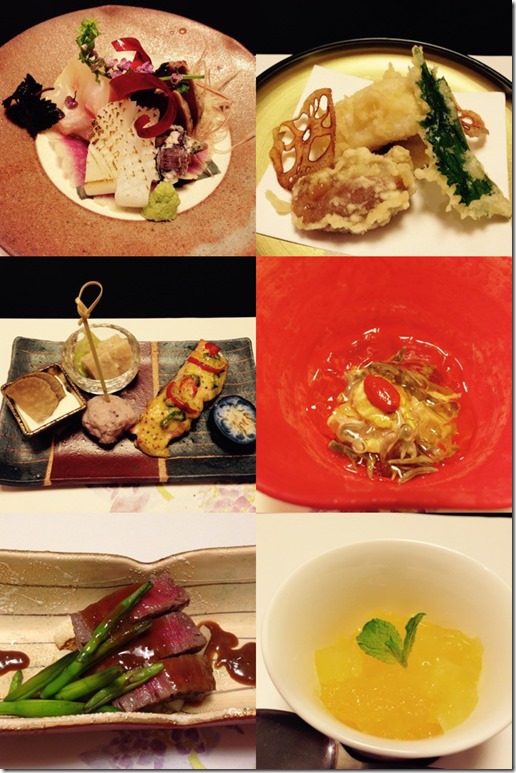
Rice and soup.
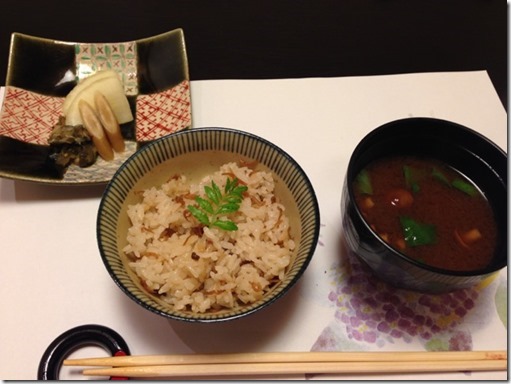
In general we really liked this restaurant. Despite a few stumbles with some of the dishes, the majority were very creative and inspiringly delicious.The service was impeccable. I am glad this level of Japanese restaurant is located very close to my mother's house.
Tuesday, November 23, 2010
Snap peas in dashi broth スナップ豌豆の塩びたし
I removed both ends of the snap peas and blanched them in salted boiling water for several minutes, until cooked but still crunchy. I drained and put in ice water to stop cooking. I drained again and patted dry with a paper towel.
Saturday, July 29, 2023
Rescued green bean soup グリーンビーンズスープ
My wife had just baked some muffins as an “apricot muffins rescue”; the fresh apricots were too mushy to eat. As part of what is turning out to be standard food rescue protocal she introduced the offending apricots to the Vita-mix and viola, she had apricot puree which she added to the muffin batter. So we had a lunch of the apricot muffin, green bean soup, sous vide chicken salad with mango, sugar snap in salt broth, corn, roasted pepper, edamame and bacon salad.
There is no recipe for green bean soup but just for the record.
Ingredients:
1 bag (32oz) fresh green beans, boiled for few minutes in salted water
1 large onion, finely chopped
1 tbs olive oil
1 tbs butter
1 cup whey (since we had it after my wife made cheese curd) (or chicken broth)
Salt and pepper to taste
Directions:
Puree the green beans in the Vita-mix or other high-power blender adding a small mount of liquid and puree until smooth
Sauté the onion in the oil and butter on medium flame until cooked but not browned
Add the green bean puree and the whey and cook for 20-30 minutes.
Using an immersion blender, blend until smooth and no onion bits remain.
Season with salt and pepper
I served this hot initially but for the left overs, I diluted it with milk and served cold which was also quite nice. This is a great way to salvage green beans that otherwise because they are too fibrous would have been thrown out.

















